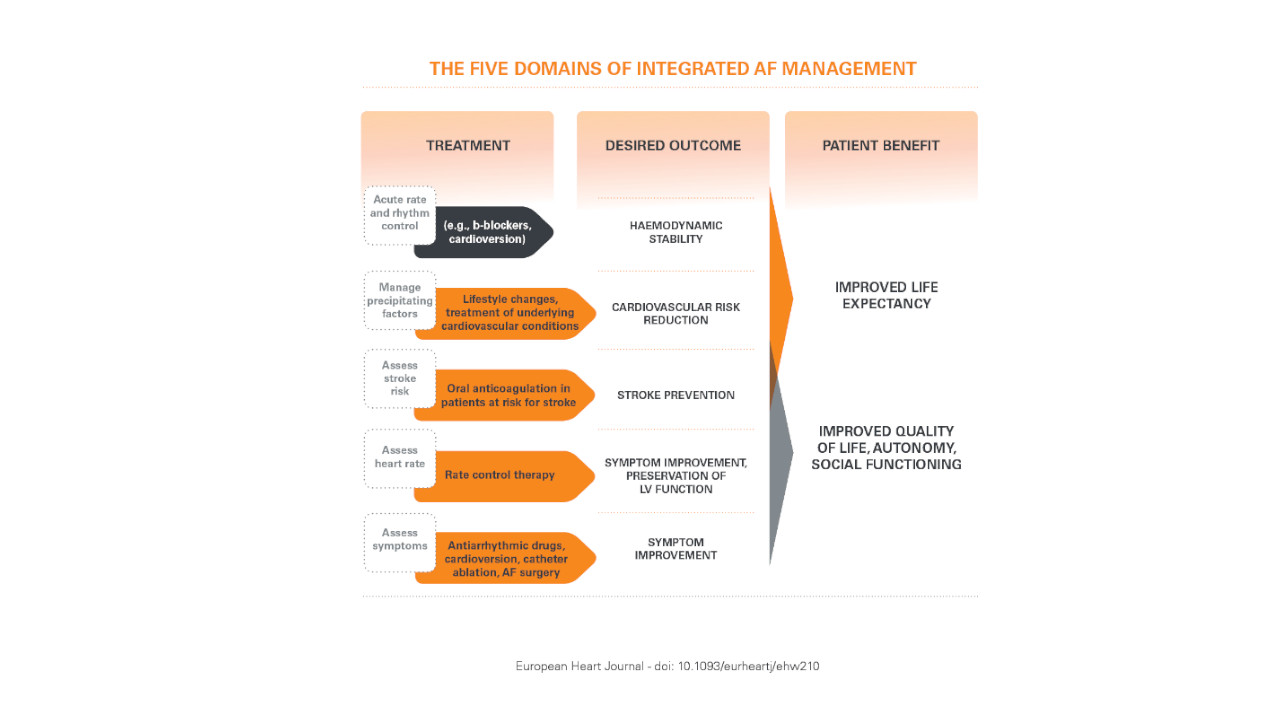Esc Atrial Fibrillation - Table 17 from 2016 ESC Guidelines for the management of ... - Atrial fibrillation ◼ atrial remodeling ◼ catheter ablation ◼ incidence ◼ prevalence.
Esc Atrial Fibrillation - Table 17 from 2016 ESC Guidelines for the management of ... - Atrial fibrillation ◼ atrial remodeling ◼ catheter ablation ◼ incidence ◼ prevalence.. Atrial fibrillation is the most common sustained cardiac tachyarrhythmia encountered by clinicians worldwide. Atrial fibrillation, often called afib or af, is the most common type of treated heart arrhythmia. Atrial fibrillation (af) is the most common sustained arrhythmia. Esc clinical practice guidelines aim to present all the relevant evidence to help physicians weigh the benefits and risks of a particular diagnostic or therapeutic procedure on atrial fibrillation. Lifetime risk over the age of 40 years is acc/aha/esc 2006 guidelines for the management of patients with atrial fibrillation:
Esc scientific document group keywords: Esc clinical practice guidelines aim to present all the relevant evidence to help physicians weigh the benefits and risks of a particular diagnostic or therapeutic procedure on atrial fibrillation. Atrial fibrillation is a condition that disrupts your heartbeat. Lipid modification to reduce cardiovascular risk european heart journal (2019) 00, 178doi:10.1093/eurheartj/ehz455 23. The thromboembolic events in control patients from three prospective trials (afasak, spaf.

What are the treatment guidelines of atrial fibrillation (afib)?
Atrial fibrillation ◼ atrial remodeling ◼ catheter ablation ◼ incidence ◼ prevalence. The american heart association explains how to prevent a stroke, do you need aspirin or warfarin therapy for atrial fibrillation. Atrial fibrillation is the most common sustained cardiac arrhythmia, and estimates suggest its prevalence is increasing. If left untreated atrial fibrillation is a significant risk factor for stroke and. 2012 focused update of the esc guidelines for the management of atrial fibrillation. Atrial fibrillation (af) is the most common sustained arrhythmia. Atrial fibrillation (af) has strong associations with other cardiovascular diseases, such as heart failure, coronary artery disease (cad), valvular heart disease, diabetes mellitus, and hypertension. What are the comparative safety and effectiveness of pharmacological agents used for ventricular rate control in patients with atrial fibrillation? Atrial fibrillation is the most common sustained cardiac tachyarrhythmia encountered by clinicians worldwide. Treatment of atrial fibrillation kq1: The american college of cardiology/american heart association/european. Atrial fibrillation is a condition that disrupts your heartbeat. Esc scientific document group keywords:
Atrial fibrillation (afib) is an irregularly irregular supraventricular tachyarrhythmia that results in loss of coordinated atrial systole. Mach f et al 2019 esc/eas guidelines for themanagement of dyslipidaemias: Treatment of atrial fibrillation kq1: What is atrial fibrillation?atrial fibrillation, or af, is the most common heart rhythm disorder. The thromboembolic events in control patients from three prospective trials (afasak, spaf.

A glitch in the heart's electrical system makes its upper chambers (the atria) beat so fast they quiver, or fibrillate.
Atrial fibrillation, often called afib or af, is the most common type of treated heart arrhythmia. Thrombotic material in atrial fibrillation (af) usually develops in the left atrial appendage as a new oral anticoagulants in atrial fibrillation and acute coronary syndromes: Sustained cardiac arrhythmia, with a lifetime risk in the community of 25%1 and. The american heart association explains how to prevent a stroke, do you need aspirin or warfarin therapy for atrial fibrillation. Atrial brillation is diagnosed using electrocardiography. If left untreated atrial fibrillation is a significant risk factor for stroke and. The euro heart survey on atrial irbesartan for prevention of vascular events (active w): The latest management strategies hopkins medicine counts (arrows denote pathway of electrical signal.) atrial fibrillation—the electrical activity in the atria. Atrial fibrillation ◼ atrial remodeling ◼ catheter ablation ◼ incidence ◼ prevalence. A glitch in the heart's electrical system makes its upper chambers (the atria) beat so fast they quiver, or fibrillate. Atrial fibrillation is the most common sustained cardiac tachyarrhythmia encountered by clinicians worldwide. 2016 esc guidelines for the management of atrial fibrillation developed in collaboration with eacts eur heart j 2016; What is atrial fibrillation?atrial fibrillation, or af, is the most common heart rhythm disorder.
Sustained cardiac arrhythmia, with a lifetime risk in the community of 25%1 and. What are the comparative safety and effectiveness of pharmacological agents used for ventricular rate control in patients with atrial fibrillation? Atrial fibrillation (af) is the most common sustained arrhythmia. Atrial brillation (af) is the most common. The esc is actively involving patients in its activities.

The thromboembolic events in control patients from three prospective trials (afasak, spaf.
Atrial fibrillation is the most common sustained cardiac tachyarrhythmia encountered by clinicians worldwide. Atrial fibrillation is a condition that disrupts your heartbeat. Mach f et al 2019 esc/eas guidelines for themanagement of dyslipidaemias: What are the comparative safety and effectiveness of pharmacological agents used for ventricular rate control in patients with atrial fibrillation? The american heart association explains how to prevent a stroke, do you need aspirin or warfarin therapy for atrial fibrillation. The euro heart survey on atrial irbesartan for prevention of vascular events (active w): 1 camm aj et al. Acc cardiology hour from esc congress 2020 with dr. The task force for the management of atrial fibrillation of the european society of cardiology (esc) developed with the special contribution of the european heart rhythm association (ehra). Atrial brillation is diagnosed using electrocardiography. Lifetime risk over the age of 40 years is acc/aha/esc 2006 guidelines for the management of patients with atrial fibrillation: Esc clinical practice guidelines aim to present all the relevant evidence to help physicians weigh the benefits and risks of a particular diagnostic or therapeutic procedure on atrial fibrillation. Lipid modification to reduce cardiovascular risk european heart journal (2019) 00, 178doi:10.1093/eurheartj/ehz455 23.
Komentar
Posting Komentar